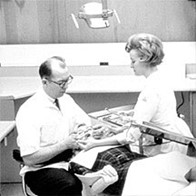The University of Alabama at Birmingham School of Dentistry was barely a decade old when the 1960s rolled around, and it already was receiving accolades. The time was right to start taking some major steps toward growth and progress.
 By adding a dental assistant or hygienist to the practice environment, UAB researchers and clinicians made treatments more efficient and effective.The SOD did exactly that throughout the 1960s, with several notable changes and improvements. These included the development of new dental techniques, the opening of the Dental Education and Research Building in 1964, the hiring of several key faculty members, and the expansion of the incoming dental classes. Here is a quick look at a few of the highlights from that decade:
By adding a dental assistant or hygienist to the practice environment, UAB researchers and clinicians made treatments more efficient and effective.The SOD did exactly that throughout the 1960s, with several notable changes and improvements. These included the development of new dental techniques, the opening of the Dental Education and Research Building in 1964, the hiring of several key faculty members, and the expansion of the incoming dental classes. Here is a quick look at a few of the highlights from that decade:
A change in leadership: Aside from a one-year hiatus in 1960-61, Dr. Joseph Volker served as Dean of the School of Dentistry from its inception in 1948 until 1962, when he moved into the role of Vice President for Health Affairs on his way to being named president of the entire UAB campus in 1969.
Volker was replaced as dean by Dr. Charles McCallum, who had served as chair of the Department of Oral Surgery since 1958. Not only did McCallum provide stability in the dean’s role for another 16 years, he followed Volker’s lead and became UAB president in 1987.
Jack Lemons, Ph.D., Professor Emeritus in the School of Dentistry, has been at UAB since the 1960s and says McCallum was the ideal choice to take over from Volker and keep the SOD moving forward.
“Dr. Volker encouraged collaboration and wanted the School of Dentistry to be very active on a campus-wide basis, and he was really educating people to follow his lead,” Lemons says. “One of the people who did that was Dr. McCallum.”
“He really believed in everyone working together and having a voice. He recruited people who would be active contributors. That’s the kind of people he wanted here. Then he was always very helpful once you got here. He was a fantastic listener. He would listen to what you had to say, then offer advice on things he knew about that you didn’t. He was a real leader of people.”
Like Volker before him, McCallum was a firm believer that dentistry is an important component of the overall medical profession. He declared as much in a letter to the SOD graduating Class of 1965 that was published in the Dentala yearbook.
“All dental schools in this country are integral parts of universities,” McCallum wrote. “Our young profession’s rapid acceptance is in part an indication of the public’s recognition of dentistry as a learned health science.”
A change in students: Like many elements of society, dentistry was a male-dominated profession throughout the 1950s, and the SOD classes reflected that reality.
Even though Claudia Holcombe Heard and Ruth Ehricke became the first female graduates of the School of Dentistry in 1954, female SOD students remained such a rarity that the 1962 Dentala included a passage stating, “Only one female dared venture into this freshman dental class, which was not too unusual in a profession long dominated by the male sex.”
That gradually started changing in the 1960s, as women began to break the enamel ceiling. But while progress was being made, it occurred very slowly. In fact, 1969 SOD graduate Dr. Karen Clements-Crunk once recalled that she still was the only female in her class when she arrived at UAB in 1965.
“I didn’t think there’d be many women in my class, but I didn’t know I’d be the only one,” Clements-Crunk said. “It was a strange feeling. My mother and father encouraged my pursuit of medicine. I was an only child and, in their eyes, I could do anything. It didn’t occur to them that it would be ground-breaking, even though most of the physicians they knew were male.”
“(During) clinic, the only place we had for women to hang out in was the women’s restroom across from the cafeteria. It was set up as a lounge and there were a couple of tables in there, so we used to eat our lunch in the restroom.”
But Clements-Crunk persevered and went on to become the SOD’s 14th female graduate. She spent 30 years in private practice as a pediatric dentist, helping pave the way for numerous other women who entered the profession behind her.
A change in technique: The duties for a dental assistant used to be confined primary to making patient appointments, updating dental records and maybe polishing teeth. But when it came time to perform most dental procedures, the dentist was the only one taking a hands-on approach.
But thanks to government-funded research that took place at UAB in the 1960s, a new technique called “four-handed dentistry” was developed. Simply put, it was determined that with a little coordination between dentist and assistant, four hands could be much more effective than two in handling a patient’s dental needs.
SOD researchers and clinicians demonstrated that the four-handed technique provided better and faster care for the patients, and reduced stress and fatigue on the dental professionals. This also occurred about the same time that reclining dental chairs were becoming an industry standard, making it even easier for the four-handed technique to work.
By the late 1970s, four-handed dentistry was adopted as the standard of care worldwide. And it all started right here at the UAB School of Dentistry.